 St John's Church Watford
St John's Church Watford
The 1911 J.W.Walker & Sons Organ

The beautiful organ in St John's was built in 1911 by the renowned London firm of J.W.Walker and Sons. Since that time the instrument has been carefully maintained, and fortunately not 'improved' as tastes have changed, so that it remains today a wonderful musical testimony to a bygone age whilst still supporting worship in the church to this very day.
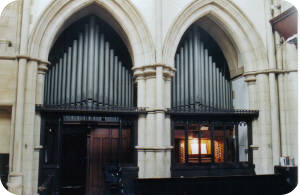
Joseph William Walker founded his business in 1827, based initially in Soho, having apprenticed with George Pike England since 1818. On his death in 1870, aged 68, his son James John took over the business single-handed until his sons joined him. Major instruments by this firm, one of the country's greatest, include those at Bristol Cathedral (1907), St Margaret's Church, Westminster (1897), Romsey Abbey (1858), St Mary's Church, Portsea (1891), and, closer to home, Harrow School Chapel (1921). The firm of J.W.Walker and Sons, Ltd., continues to this day, and more recent examples of its work include Blackburn Cathedral (1967), Liverpool Metropolitan Cathedral (1967), St Chad's RC Cathedral Birmingham (1993), Lancing College (1986 - using much pipework from the previous 1914 Walker organ) and Bolton Town Hall (1982).
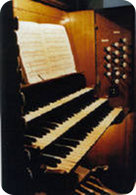
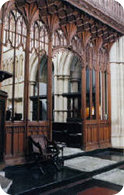
In the two decades leading up to the twentieth century organ building saw some radical new ideas be toyed with - J.W.Walker and Sons remained firmly traditional, relying on diapasons of 'magnificent "rolling" tone' of startling proportions to form the foundation of their instruments. No wonder the esteemed Parisian builder Aristide Cavaillé-Coll is reputed to have described such organs as "toujours rosbif!". Nonetheless, in the spirit of progression, Walkers developed their own style of reed voicing, including rather strange 'pepper pot' caps on the resonators.
Prior to installation of the current instrument in 1911, a smaller organ, also built by Walkers, was installed. It was first played during the service of consecration in 1893.
Manual
Open Diapason 8'Wald Flute * 8'
Dulciana * 8'
Principal * 4'
Flute * 4'
Fifteenth * 2'
Pedal
Bourdon 16'Manual to Pedal
Stops marked * were enclosed in a general swell box.
Two composition pedals.
This organ was replaced in 1911 by the present instrument. Nothing is known about what happened to this first instrument; perhaps it was incorporated into the current organ?
The new 1911 organ was first heard during a dedication service on 20th December, 1911, played by Dr Harold Darke (1888-1976). Harold Darke was an eminent organist in his day, for 50 years organist at St Michael's, Cornhill, in the City of London. His musical compositions are still performed around the world.
Choir I
prepared for onlyGreat II
Open Diapason 8'Wald Flute 8'
Dulciana 8'
Principal 4'
Harmonic Flute 4'
Fifteenth 2'
Trumpet 8'
Swell to Great
Swell III (enclosed)
Double Diapason 16'Open Diapason 8'
Stopped Diapason 8'
Echo Gamba 8'
Voix Celestes (tenor C) 8'
Principal 4'
Mixture III
Horn 8'
Oboe 8'
Tremulant
Swell Sub-Octave
Swell Unison Off
Swell Octave
Pedal
Open Diapason 16'Bourdon 16'
Flute (extension) 8'
Great to Pedal
Swell to Pedal
Accessories
Three combination pedals each to Great and Swell
Balanced pedal to Swell
Reversible pedal to "Great to Pedal"
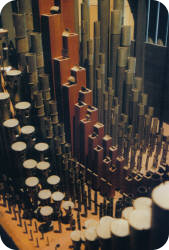
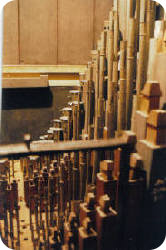
Planned as a three manual instrument of twenty-three speaking stops, the Choir division of four stops was prepared for only, with the console containing the necessary keyboard and stop knobs. The pipework was to be installed at a later date, presumably when funds allowed. Sadly the Choir remains silent, and it seems unlikely that the organ will ever be finished now.
Despite this, the organ remains as a wonderful testament to the organ building of yesteryear, with rolling diapasons, close-toned reeds, and a small but ponderous Pedal department. The organ has been well maintained over the years, and despite a few minor faults (occasional ciphers, the odd missing note) it is an absolute delight to play. It certainly cannot be called an eclectic instrument, but it is inherently musical, and thus in the hands of a sympathetic player can cope ably (if not authentically) with all schools of music. Its heart though, of course, lies in the Edwardian/Victorian repertory, and music from the pens of Charles Stanford, Herbert Howells, Hubert Parry and Edward Elgar (to mention just a few) is perfectly at home on this wonderful instrument.
At first glance the siting of the organ in the spacious building would appear rather hopeless, tucked well away in the south-east corner with little chance for its tone to reach through the church. However, this is far from the case - admittedly its effect is perhaps most striking from the console directly in front of the Great and Swell pipework, but moving down into the main body of the church sees the tone become warmer and considerably rounder. The effect, even from the very back, is one of powerful weight and smooth grandeur, serene colour and gorgeous tranquillity, at once able to thrill and seduce.
In 2017 this wonderful organ was awarded the Grade II* Historic Organ Certificate by the British Institute of Organ Studies, recognising the historical nature of this organ that remains in its original, untouched condition since its installation in 1911. The listing marks the organ as being one of particular importance within the UK, and of more than special interest.

SAFEGUARDING

 DONATE TO ST JOHN'S
DONATE TO ST JOHN'Swith ChurchSuite

PRAYER REQUEST

NEWSLETTER
Upcoming Services and Events
Friday 12th December
5.30pm - Evening Prayer
Sunday 14th December
The Third Sunday of Advent
10.30am - Parish Mass with Hymns
Monday 15th December
8.00am - Morning Prayer
Tuesday 16th December
5.30pm - Evening Prayer
Wednesday 17th December
10.00am - Said Mass with Lectio Divina
Friday 19th December
5.30pm - Evening Prayer
Sunday 21st December
The Fourth Sunday of Advent
10.30am - Parish Mass with Hymns
6.00pm - Carols by Candlelight
Join us at St John's over Christmas...click here to see our special Christmas services.


